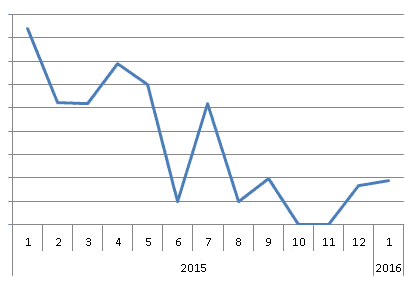At the end of last week Shutterstock announced it was about to change its royalty rates for Extended Licenses. You can read the details of the changes on microstockdiaries. Announcing the change would take place and then letting us wait a few days for the change to appear on the payouts page was uncharacteristically limp-wristed for Shutterstock.
Simplification to a Flawed Model
It's still beyond me how a flat rate is less simple than a series of payment tiers based on previous earnings (apart from an obvious attempt to sugar-coat the bad news). What is interesting is that it's a choice that places Shutterstock further into a tiered payment model that istock claimed was simply unsustainable when making major changes to the royalty structure back in 2010.
The change itself I don't see as that significant as it stands (I'm sure some of you will be upset, and I hear you all saying it's easy in your position with a small pay rise). But it's alarming when combined with the other little slices that Shutterstock have taken in the past couple of years, it seems pretty obvious there is more to come if a near 30% growth in revenue is to be maintained.
It was only a matter of time before the spotlight fell onto photographer royalties, we don't really know what happens inside the machine, we're just able to spot patterns in what we see on the outside. While wearing one of my other hats I earn money referring buyers to stock agencies like Shutterstock, some of the changes that spring to mind are related to referrals not directly to photographers or buyers:
Cuts to Photographer Referral Lifetime (shutterstock forum, Feb 2013)
I'm also watching buyer referral payouts dwindle:

I'm not too sure what to make of it. Shutterstock was once a strong earner for me, last years results were less than pleasing (to the point of my now sending buyers to depositphotos).
[Background on the graph above: traffic, page views, visitor sources, etc at the website these stats relate to were level across the year, nothing changed in layout of the site or traffic from search etc. Other than site visitors potentially being 'saturated' with Shutterstock subscriptions, I really don't know what's happening here, and I'm interested to hear from anyone else working in the market.]
For what is worth, my income as a photographer is going up (or at the very least standing still when viewed pro-rata with images I'm adding to my portfolio, considering the growth of the image collection at Shutterstock that can't be ignored as a counterpoint to this.
Is the Shutterstock Bubble about to Burst?
The alarming paragraph title is perhaps not so warranted, we have been there before with iStock; it took several years for the 'clear market leader' to lose their shine, there probably won't be a burst. We should also note that iStock also made numerous business decisions I felt to be "completely surreal" before it became noticeable that they had lost so much ground the downturn was irrevocable. Shutterstock not made such dreadful choices so far (you might argue this is one), but they are definitely now heading down a similar path. That path might have been inevitable from the day they floated.
Minimum Viable Payout Rate
The big question for Shutterstock is how to find that payout rate. Cut the rate too much and contributors will leave, make it too high and the shareholders will want blood. Leaving it alone is also a cut in real terms.
As contributors in mainstream microstock we have little choice at all in the matter, but to get paid the market rate or leave it. That rate is complex, it's spread across multiple agencies and is dependent on the success of that agency, minimum quality of content buyers expect and more.
Like paying an employee the right salary, the choice can't be simply made by reducing until the employee leaves: they might not be happy to come back when offered a tiny bit more than what they felt was not enough.
With the recent Getty / Corbis collection deal, Fotolia + Adobe + Subscription in the Creative cloud, and several convincing looking start-ups vying to take their own little slice of subscriptions market, the future looks decidedly "dynamic".



Excellent analysis
Lee Torrens (not verified) on Tue, 2016-01-26 13:46Steve, excellent analysis as always.
I think what was "unsustainable" about iStock's royalty structure was that the royalty percentage was based on lifetime sales, not how much was selling in the current period, so a lot of early adopters whose portfolios hadn't improved in quality with the rest of the site were earning the top royalty rates. And that quantity was going to grow over time with no relationship to the value those contributors were creating. Technically it wasn't "unsustainable" in the true meaning of the word, but it would have driven iStock to a point where they were paying all contributors the top royalty rate which at the time was, shock horror, 40%.
What I think is important in the bigger picture about Shutterstock's current issues is their diversification. They don't break down revenue or profits by business unit (they have SEVEN separate-but-related businesses) so it's very possible that there's a slowing of growth in Shutterstock images which they're making up for through other business units.
So with that, it's entirely possible - and not unlikely - that the downtrends you see in your sales and referral stats are consistent with Shutterstock's 30% growth as a whole.
And I totally agree with you that lowering the minimum payout threshold and lowering the entry requirements were intended to lower the overall royalties amounts paid to contributors, sacrificing image quality and efficiency for higher profits. That's fine for shareholder, but not for customers.
Thanks also for the link!
Models and Business Units
Steve Gibson on Wed, 2016-01-27 00:37Ditto to that on your post (some useful stuff there, and hence the link - and no need for me to rewrite some of the same thing!)
"I think what was "unsustainable" about iStock's royalty structure was that the royalty percentage was based on lifetime sales, not how much was selling in the current period, so a lot of early adopters whose portfolios hadn't improved in quality with the rest of the site were earning the top royalty rates."
Is that not the same as Shutterstock now? percentages that go up with lifetime earnings? (to a limit, or have I missed something?)
(I thought that when istock said that it was B.S. pretty sure there would be a technology solution to lower those older lower quality images in the search. There were canister tiers too, it's not like contributors kept earning a larger percentage until it was 100%)
I don't think for a minute that Shutterstock are selling less, I've always thought those other units were tiny in comparison to photo sales (but i'm not well informed on that). What I see is then tightening up everywhere (arguably that's good business) but the tightening will continue.
'As contributors in
Ralph Degen (not verified) on Sat, 2016-10-29 22:32